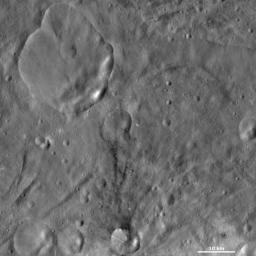This Dawn Framing Camera (FC) image of Vesta shows Urbinia and Sossia craters. Urbinia is the large crater, which dominates the top left of the image, and Sossia is the small crater surrounded by dark material in the bottom of the image. Urbinia crater is a distinctive crater for many reasons: it has a fresh and very irregularly shaped rim; there is a younger, smaller crater near its center and there are patches of dark and bright material around its rim, which slump towards its center. The quadrangle in which Urbinia is located is named after it because of the individuality of the crater. Sossia crater is much smaller than Urbinia, Sossia is 8 kilometers (5 miles) in diameter and Urbinia is 24 kilometers (15 miles) in diameter. But, it is also an interesting crater because of the dark material associated with it.
This image is located in Vesta's Urbinia quadrangle, in Vesta's southern hemisphere. NASA's Dawn spacecraft obtained this image with its framing camera on Oct. 13, 2011. This image was taken through the camera's clear filter. The distance to the surface of Vesta is 700 kilometers (435 miles) and the image has a resolution of about 67 meters (220 feet) per pixel. This image was acquired during the HAMO (high-altitude mapping orbit) phase of the mission.
The Dawn mission to Vesta and Ceres is managed by NASA's Jet Propulsion Laboratory, a division of the California Institute of Technology in Pasadena, for NASA's Science Mission Directorate, Washington D.C. UCLA is responsible for overall Dawn mission science. The Dawn framing cameras have been developed and built under the leadership of the Max Planck Institute for Solar System Research, Katlenburg-Lindau, Germany, with significant contributions by DLR German Aerospace Center, Institute of Planetary Research, Berlin, and in coordination with the Institute of Computer and Communication Network Engineering, Braunschweig. The Framing Camera project is funded by the Max Planck Society, DLR, and NASA/JPL.
More information about Dawn is online at http://www.nasa.gov/dawn and http://dawn.jpl.nasa.gov.

 Planetary Data System
Planetary Data System












